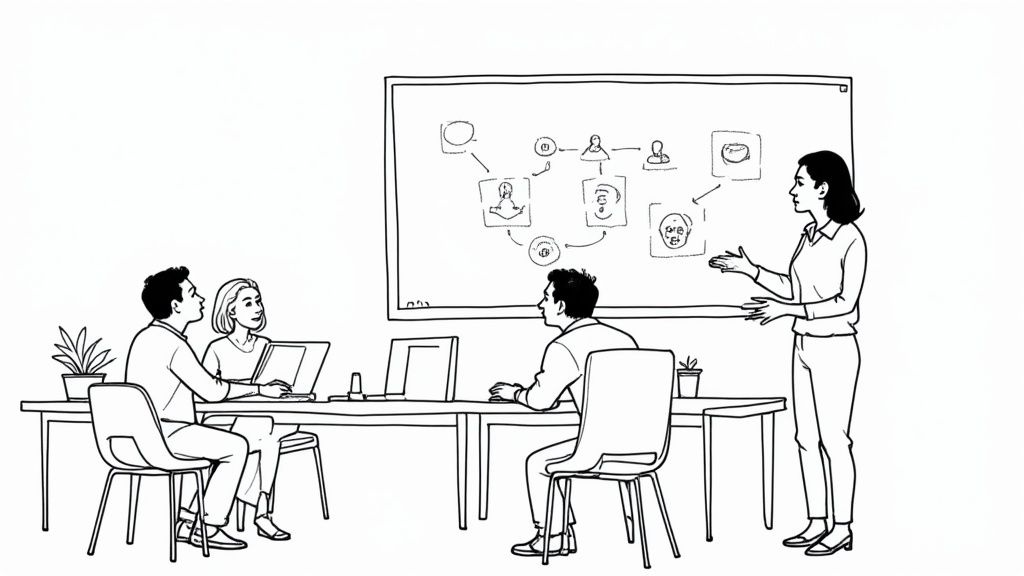The Hidden Impact of Workplace Conflict on Your Business

Workplace conflict extends far beyond the individuals directly involved. Its effects ripple throughout the organization, impacting team dynamics, productivity, overall morale, and even profitability. Addressing conflict quickly and effectively isn't simply about maintaining peace; it's a vital business strategy.
The Human Cost of Conflict
One of the most significant, yet frequently overlooked, consequences of workplace conflict is its impact on mental health. Those involved in disputes often experience increased stress, anxiety, and even depression. This not only affects individual well-being but also contributes to a decline in overall team performance and productivity.
For instance, a team member struggling with stress from a conflict may find it difficult to concentrate, leading to errors and missed deadlines.
Unresolved conflict can also lead to decreased job satisfaction and increased absenteeism. Employees might feel less motivated to come to work, call in sick more often, or begin searching for new employment opportunities. This loss of talent can be expensive for businesses, impacting productivity and increasing recruitment and training costs.
The Business Bottom Line: Conflict's Financial Impact
Beyond the human cost, workplace conflict has a significant financial impact on businesses. It's a widespread issue, affecting millions of workers globally and leading to considerable consequences for both mental health and organizational outcomes. Between 2018 and 2019, approximately 35% of employees surveyed reported experiencing some form of conflict at work, impacting roughly 9.7 million workers worldwide.
Despite its prevalence, most employees chose to remain with their organizations. However, the effects of conflict resulted in 5% of affected employees resigning and 9% taking sick leave related to the conflict. Importantly, over half (56%) of those experiencing conflict reported increased stress, anxiety, or depression. This highlights the serious psychological toll of workplace disputes. These statistics are detailed further at Pollack Peacebuilding.
This data underscores the importance of proactive conflict resolution in the workplace. Implementing strategies and training programs to directly address conflict can help mitigate these negative consequences and foster a healthier, more productive work environment. However, many organizations fail to invest in these essential resources, ultimately hindering their growth and success.
The Real Price Tag of Unresolved Workplace Tensions

Beyond the obvious discomfort, unresolved workplace conflict carries a significant financial burden. It impacts a company's bottom line and overall success. Many leaders overlook the true cost, focusing on immediate interpersonal problems instead of the wider organizational consequences. This section explores the quantifiable financial impact of workplace disputes. It reveals why conflict resolution is not just about employee well-being, but a crucial business necessity.
Quantifying the Costs of Conflict
The financial burden of workplace conflict appears in several ways. Productivity suffers as employees spend time and energy dealing with disputes instead of their work. This lost output directly translates to lost revenue and missed opportunities.
Consider the management time spent addressing conflicts. Studies show managers dedicate between 20% to 40% of their time to conflict resolution. This is time that could be used for strategic initiatives, employee development, or other valuable activities.
Unresolved conflicts often increase absenteeism and presenteeism. Employees stressed by conflict may take more sick days. Even when present, they may be less productive. This impacts output and, ultimately, profits. The cost of replacing employees who leave due to unresolved conflicts is also substantial. Recruitment, onboarding, and training all add up.
The impact extends beyond immediate productivity losses. There are less obvious, but equally important, financial consequences. Damaged client relationships due to internal conflicts can hurt the business. Decreased innovation as teams struggle to collaborate stifles growth. Compromised decision-making in tense work environments leads to poor choices. All of these contribute to the financial drain.
To understand the scope of the problem, let's look at some statistics. Workplace conflicts consume significant time and resources. Employees spend an average of 2.8 hours per week managing or resolving disputes. This results in an estimated $359 billion annual loss in productivity across U.S. businesses. Managers allocate 20% to 40% of their time to address conflicts, further straining resources. For more detailed statistics, see this article. The ripple effects of unresolved conflicts go beyond lost hours. They diminish collaboration and overall team efficiency. This investment of time and money highlights the benefits of proactive conflict resolution strategies.
The following table summarizes the financial implications of workplace conflict at different levels:
The Financial Impact of Workplace Conflict
This table illustrates the various costs associated with workplace conflict across different organizational levels.
| Cost Category | Per Employee Impact | Organizational Impact | Prevention Opportunity |
|---|---|---|---|
| Lost Productivity | 2.8 hours per week | $359 billion annually (US) | Conflict resolution training |
| Management Time | N/A | 20-40% of manager's time | Improved communication processes |
| Employee Turnover | Increased recruitment, onboarding, and training costs | Loss of institutional knowledge, decreased team cohesion | Proactive conflict management systems |
| Damaged Client Relationships | Potential loss of revenue and future business | Reputational damage | Early intervention and mediation |
| Decreased Innovation | Reduced development of new products/services | Loss of competitive advantage | Fostering a collaborative work environment |
This table clearly demonstrates the far-reaching financial burden of workplace conflict, impacting individual employees, teams, and the entire organization. Investing in preventative measures, such as conflict resolution training and improved communication, can significantly reduce these costs and improve overall organizational health.
The Intangible Costs: A Deeper Dive
While quantifiable costs are significant, the intangible costs are just as damaging, if harder to measure.
- Erosion of Trust: Ongoing conflicts can erode trust between colleagues, impacting teamwork and creating a negative atmosphere.
- Damaged Morale: A tense and conflicted workplace decreases morale and job satisfaction.
- Reputational Damage: Publicly known conflicts can negatively impact an organization's reputation and make it harder to attract talent.
These intangible costs significantly affect long-term organizational health and success. They impact employee engagement, retention, and the ability to attract and keep top talent. Investing in conflict resolution training and systems, such as those offered by Happily.ai, helps organizations mitigate these costs, both tangible and intangible. By fostering a culture of proactive conflict resolution, companies can create a more positive, productive, and financially healthy work environment.
Uncovering Why Your Team Is Really Fighting

Workplace conflicts rarely erupt solely over the incident that brought them to light. More often, simmering issues beneath the surface finally boil over. Truly resolving these conflicts requires understanding their root causes. This allows for lasting solutions and a healthier work environment. It means digging deeper than the immediate disagreement to discover the real sources of friction. This section will explore common conflict triggers and provide frameworks for diagnosing the root causes.
Common Conflict Triggers
Several recurring themes contribute to workplace conflict. Communication breakdowns are a major source. Misunderstandings can stem from unclear instructions, poor listening skills, or ineffective feedback. This can easily lead to frustration and resentment among team members.
Personality clashes are another frequent trigger. Different work styles, communication preferences, and values can create friction between individuals. For example, a detail-oriented person might clash with a colleague who prefers a more flexible approach. If not addressed proactively, these differences can strain relationships.
Structural organizational issues also contribute. Unclear roles and responsibilities, unequal workloads, or perceived unfairness in resource allocation can breed resentment and competition. This type of conflict isn't about individual personalities, but rather systemic problems requiring organizational solutions.
Research consistently identifies key conflict causes and effective interventions. A recent Workplace Peace Institute survey pinpointed lack of trust (73%), personality clashes (72%), and unclear roles (70%) as leading triggers of global workplace conflicts. The data also highlighted that personality clashes contribute to nearly half of all workplace disputes. Learn more about these insights here.
To further illustrate the prevalence and impact of these triggers, let's examine the following table:
Primary Causes of Workplace Conflict
This comparison table highlights the most common causes of workplace conflict and their prevalence across different organizational contexts.
| Conflict Trigger | Prevalence (%) | Impact Severity | Resolution Difficulty |
|---|---|---|---|
| Lack of Trust | 73 | High | High |
| Personality Clashes | 72 | Medium | Medium |
| Unclear Roles | 70 | Medium | Low |
| Communication Breakdowns | 65 | Medium | Low |
| Unfair Workloads | 55 | High | Medium |
As the table shows, issues related to trust and personality have a high impact and can be difficult to resolve. While issues stemming from unclear roles and communication are less severe and easier to address. Understanding these differences allows organizations to prioritize interventions and allocate resources effectively.
Diagnosing the Root Cause
Identifying the root cause of conflict is a multi-layered process. It requires careful observation, active listening, and a willingness to look beyond surface complaints.
Conflict analysis frameworks can be effective tools. These frameworks break down conflicts into component parts: involved parties, the issues, the context, and the underlying interests and needs of each individual.
The "5 Whys" technique is another helpful tool. Repeatedly asking "why" a conflict occurred helps move beyond immediate symptoms to uncover deeper systemic issues. For example, if team members argue over deadlines, repeated “whys” might reveal unclear project roles or flawed communication processes.
By understanding the underlying dynamics of conflict, organizations can shift from reactive responses to proactive prevention. Implementing appropriate strategies and training programs can help prevent conflicts from arising, creating a healthier and more productive work environment. This benefits individual employees and the organization as a whole. Solutions like Happily.ai can provide resources and insights to implement these strategies and create a more positive and productive workplace.
Manager's Toolkit: Proven Conflict Resolution Techniques

This section provides managers with practical conflict resolution strategies for navigating workplace disagreements. These proven techniques can turn challenging conversations into opportunities for growth and stronger team dynamics. By understanding the subtleties of conflict resolution, managers can skillfully mediate disputes and cultivate a more harmonious work environment. This proactive approach shifts the focus from reacting to conflicts to preventing them.
Preparing for Difficult Conversations
Before addressing a conflict, careful preparation is essential. This involves gathering information from everyone involved to ensure a comprehensive understanding of each perspective.
For example, if team members disagree about project responsibilities, speak with each person individually before a joint meeting. This approach minimizes misunderstandings and demonstrates your commitment to fairness.
Next, select a neutral location for the conversation. A private room or a quiet area minimizes distractions and fosters open communication, signaling respect for all participants.
Finally, establish clear ground rules. These might include focusing on specific actions instead of personal criticisms, and ensuring each person has uninterrupted time to express their views. These guidelines create a safe space for productive dialogue.
Facilitating Productive Dialogue
Effective facilitation requires more than simply bringing people together. Active listening is paramount. Pay close attention to both verbal and nonverbal cues, demonstrating empathy and a genuine desire to understand. This builds trust and encourages open communication during conflict resolution.
Also, reframe negative language into positive, problem-solving terms. Instead of “He’s always late,” guide the speaker to rephrase as “When deadlines are missed, it impacts the project timeline.” This shift reduces defensiveness and promotes solution-oriented discussion.
Finding common ground is another vital technique. Even in heated disagreements, shared goals or values usually exist. Highlighting these commonalities helps bridge divides and encourage collaboration. For instance, reminding disagreeing team members of their shared commitment to project success can refocus the conversation.
Following Up for Lasting Resolution
Conflict resolution doesn't conclude with a single meeting. Follow-up is crucial to ensure agreements are upheld and issues don't resurface. This might involve scheduling check-in meetings, monitoring progress on agreed-upon actions, or offering additional support.
Documenting the conflict and the agreed-upon resolution is also important. This creates a valuable record for future reference, helps track progress, and provides insights for preventing similar conflicts. This documentation also promotes accountability.
Finally, consider using resources like Happily.ai for ongoing support and to foster a positive work environment. The platform’s conflict resolution tools can help teams develop stronger communication skills and create a more collaborative culture. This contributes to long-term conflict resolution and a more productive and positive workplace. By integrating these strategies, managers can transform conflicts from disruptions into opportunities for growth and improved team dynamics.
Creating a Workplace Where Healthy Conflict Thrives
Beyond resolving individual disputes, organizations can cultivate a workplace culture where conflict is viewed not as a negative, but as an opportunity for growth and innovation. This involves shifting perspectives, implementing systemic changes, and fostering an environment of psychological safety where productive disagreement can flourish. This section explores how to create such a culture, moving from reactive conflict management to proactive strategies that strengthen teams and drive positive change.
Building a Foundation of Psychological Safety
Psychological safety is the cornerstone of a healthy conflict culture. It's the shared understanding that team members can speak up, express different viewpoints, and even make mistakes without fear of negative repercussions. When psychological safety is present, individuals feel comfortable taking interpersonal risks, such as voicing dissenting opinions or challenging the status quo. This, in turn, leads to more robust discussions, more creative problem-solving, and ultimately, better decision-making.
Building psychological safety requires conscious effort from leadership. Leaders can model vulnerability by admitting their own mistakes and encouraging open feedback. Actively listening to different perspectives and responding respectfully, even when disagreeing, reinforces the message that all voices are valued.
Establishing Clear Communication Norms and Escalation Pathways
Clear communication norms are essential for managing conflict constructively. These norms define how team members interact during disagreements, ensuring respect and professionalism. For example, norms might include focusing on specific behaviors rather than personal attacks, actively listening without interrupting, and using “I” statements to express feelings and needs.
Equally important are clear escalation pathways. These pathways provide a structured approach for addressing conflicts when they arise, preventing situations from escalating unnecessarily. A clear process might involve first addressing the issue directly with the individual involved. Then, if the conflict persists, escalating to a team leader or manager. Finally, involving HR or a mediator if necessary. This structure empowers individuals to take ownership of conflict resolution while providing support when needed.
Developing Conflict Resolution Values and Mediation Skills
Embedding conflict resolution values into the organizational culture goes beyond simply providing training. It involves creating a shared understanding of how conflict is viewed and approached within the team. These values might include:
- Respectful Communication: Emphasizing respectful and professional communication, even during disagreements.
- Empathy and Understanding: Encouraging team members to understand each other's perspectives and needs.
- Collaboration and Problem-Solving: Focusing on finding solutions that benefit all parties involved.
Alongside these values, developing mediation skills throughout the organization can empower individuals to address conflicts constructively. This might involve formal mediation training for managers and team leaders. Or, it could involve providing resources and tools for all employees to develop their conflict resolution skills. These skills equip individuals to facilitate difficult conversations, find common ground, and guide their colleagues towards mutually acceptable solutions.
Implementing Systematic Change and Measuring Progress
Transforming a workplace culture requires more than just addressing individual conflicts; it requires systematic change to policies, training programs, and leadership approaches. Organizations can integrate conflict resolution principles into onboarding programs, performance reviews, and leadership development initiatives. This ensures that these principles are not just taught, but actively practiced and reinforced throughout the organization.
Finally, measuring progress toward a healthier conflict culture is essential. This can be achieved through regular team surveys, feedback sessions, or by tracking the number and severity of reported conflicts. These metrics provide valuable insights into the effectiveness of implemented strategies and identify areas for improvement. Platforms like Happily.ai offer tools and resources for tracking these metrics, fostering ongoing dialogue, and continuously improving the workplace culture. By embracing a proactive approach to conflict resolution, organizations can create a more collaborative, innovative, and ultimately, more successful work environment.
Transforming Workplace Tensions Into Breakthrough Opportunities
What if workplace conflict wasn't a source of anxiety, but a catalyst for positive change? This section reframes workplace disagreements as potential opportunities for growth when handled effectively. Instead of viewing conflict as purely negative, we'll explore how it can spark innovation, build stronger teams, and cultivate a more resilient organization.
Learning From Conflict: Turning Disagreements Into Insights
Many organizations miss a valuable learning opportunity by simply trying to "resolve" conflicts and move on. However, disagreements often expose underlying issues within teams or processes. This means analyzing the root causes of conflict can provide valuable insights leading to improvements.
For example, recurring conflicts about project deadlines might indicate a need for clearer communication protocols or better resource allocation. Similarly, disagreements about roles and responsibilities can highlight ambiguities in job descriptions or organizational structure.
By conducting thorough post-conflict debriefs, organizations can capture these lessons and prevent similar issues in the future. These debriefs should focus on understanding everyone's perspective, identifying systemic issues, and developing actionable solutions.
Building Resilience: Developing a Growth Mindset Around Conflict
Conflict is an inevitable part of any workplace. Therefore, developing personal resilience is crucial for navigating disagreements effectively. This involves shifting from a mindset of fearing conflict to viewing it as an opportunity for growth.
One key aspect of resilience is managing emotional responses during disagreements. Learning techniques for staying calm and focused when facing criticism can prevent unproductive escalations.
Additionally, developing empathy and active listening skills can help individuals understand others' perspectives, fostering more collaborative solutions. Adopting a growth mindset transforms challenges into opportunities for professional development.
Implementing Conflict-Driven Improvements: A Framework for Action
Transforming insights into real improvements requires a structured approach. Here's a framework for implementing conflict-driven change:
- Capture Lessons Learned: Document the key takeaways from post-conflict debriefs, ensuring they are formally recorded.
- Develop Actionable Plans: Translate insights into specific action items, assigning ownership and deadlines to ensure accountability.
- Integrate into Training: Incorporate conflict resolution principles and best practices into employee training programs. This reinforces a culture of proactive conflict management.
- Monitor Progress: Track the implementation of action plans and measure their impact on conflict reduction and team performance.
- Continuously Improve: Regularly review conflict resolution processes and adapt them based on feedback and ongoing evaluation.
By embracing this framework, organizations can create a continuous improvement cycle, turning workplace tensions into opportunities for growth and innovation. This fosters a more positive, collaborative, and ultimately, more successful work environment.
Ready to transform your workplace culture and turn conflict into a catalyst for growth? Happily.ai offers comprehensive tools and resources to help you build a more positive and productive work environment. Explore our platform today and discover how we can empower your team to navigate disagreements constructively and achieve breakthrough results.









